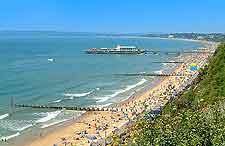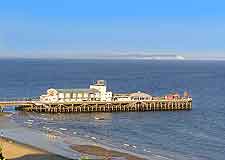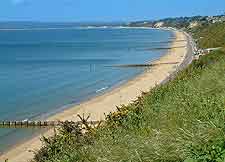Bournemouth History Facts and Timeline
(Bournemouth, Dorset, England)

For centuries in history, people have lived on the site that was to become Bournemouth. A Stone Age camp here dates back over 12,300 years. There was also an active Iron Age port. By the early 15th century, records show the existence of a settlement known as 'La Bournemowthe'. However, it's not until the early 19th century that Bournemouth came into being as an actual town - one that was carefully planned.
Whilst Bournemouth is a bustling seaside resort today, this hasn't always been the case. Once, it was a place where visitors went to seek solitude.

The Founding of Bournemouth
Dorset Volunteer Ranger, Captain Lewis Tregonwell had been visiting the area for many years, keeping an eagle eye out for the threat of Napoleonic invasion during the closing years of the 18th century.
Then, in 1810, he happened to visit once again, this time on holiday with his wife. She liked the locality so much that she persuaded her husband to lease land near Bourne Stream on which to build a mansion. The mansion is now the Royal Exeter Hotel.
Bournemouth grew up, then, as a place of retreat for wealthy Victorians - a place of glorious isolation, where you could escape the realities of life. Working-class residents were even kept a good distance away by building cottages well away from the luxury villas, in Winton and Springbourne. Bournemouth at that time didn't even have shops, which it was thought would disturb the peace. Instead, groceries and provisions had to be brought all the way from nearby Poole and Christchurch.

Victorian Bournemouth
News that plans were afoot to bring the railway to Bournemouth was not well received. When the town's residents finally agreed to a railway station being built, they insisted on a particularly deep cutting to ensure that the new-fangled trains could arrive in town without really being seen.
History records that it fell on the shoulders of Christopher Crabbe Creeke, a town commissioner, to bring Bournemouth into the 19th-century proper. He laid out roads, built villas and improved the town's drains. Other developers succeeded in building terraced housing and shopping arcades where visitors could buy 'fancy goods' and souvenirs. By the end of the 19th century, Bournemouth had been transformed from a retreat into a resort, where you could come to enjoy a holiday by the sea.
In 1890, Queen Victoria granted Bournemouth the status of a borough, giving its residents a chance to have more of a say about what happened in their town. Several parks were laid out and public buildings arrived, including hospitals and libraries. The Undercliff Drive was constructed on the seafront. Visiting Kaiser Wilhelm is said to have enjoyed a motor trip along it.
A 20th Century Town
From the time that Bournemouth's famous pier opened to the public in 1929, the town expanded rapidly. The town's boundaries soon swallowed up smaller neighbouring resorts, such as Boscombe Spa. The original workers' cottages were also subsumed within the town's limits.
During the 1920s and 1930s, middle-class suburbs rose up in places like Talbot Woods and Richmond Park. By the 1950s, this had become a major town, and in 2010, Bournemouth celebrated its bi-centenary.
 For centuries in history, people have lived on the site that was to become Bournemouth. A Stone Age camp here dates back over 12,300 years. There was also an active Iron Age port. By the early 15th century, records show the existence of a settlement known as 'La Bournemowthe'. However, it's not until the early 19th century that Bournemouth came into being as an actual town - one that was carefully planned.
For centuries in history, people have lived on the site that was to become Bournemouth. A Stone Age camp here dates back over 12,300 years. There was also an active Iron Age port. By the early 15th century, records show the existence of a settlement known as 'La Bournemowthe'. However, it's not until the early 19th century that Bournemouth came into being as an actual town - one that was carefully planned.
